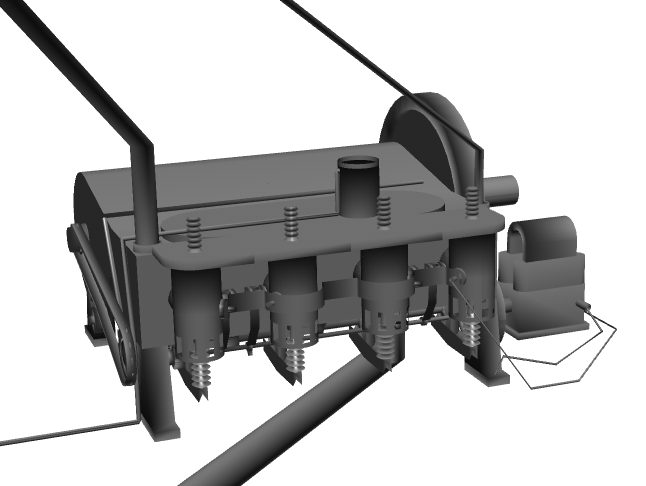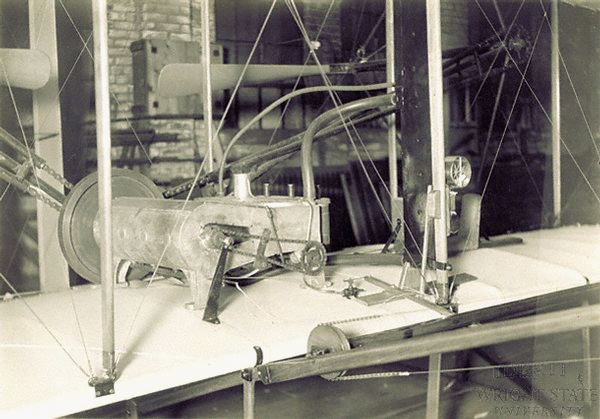Engine Interactive

Combustion
This is an animated computer drawing of the Wright brothers’ 1903 aircraft engine. This machine powered the first, heavier than air, self-propelled, maneuverable, piloted aircraft; the Wright 1903 Flyer, flown at Kitty Hawk, North Carolina, in December 1903. To generate thrust for their aircraft, the brothers used twin, counter-rotating propellers at the rear of the aircraft. To turn the propellers, the brothers designed and built a gasoline powered internal combustion engine.
At the time of the brothers first flight, most of their contemporaries did not use gasoline powered internal combustion engines for flight. Langley, Maxim and Ader had used steam power in their early designs. Langley used a gasoline powered engine on his larger Aerodrome. Herring had experimented with a compressed gas system. But time has shown that the choice made by the brothers was the correct one. Until the invention of the jet engine, nearly every aircraft was powered by internal combustion engines.
Engine Design
The basic mechanical design of the Wright engine is remarkably similar to modern, four-stroke, four-cylinder automobile engines. Obviously, the brothers’ design is much, much simpler than modern high-performance engines, but it is an excellent engine for students to study to learn the fundamentals of engine operation. Individual web pages for all of the major systems and parts are provided so that you can study each item in some detail.
Engine Parts
The 1903 engine was a water-cooled machine. On the figure at the top of this page, we show the single radiator feed hose at the bottom and twin radiator return hoses on the top of the engine. In the Java program we have removed the coolant lines for clarity. We have also tilted the engine at an angle so that you can easily see features on both the upper and lower surfaces of the engine.
The large flywheel which is used to damp out vibrations from the engine is seen at the back of the engine. Near the flywheel is the magneto which generates the electricity for the ignition system. The four cylinders on the side of the engine are actually the combustion chambers in which the fuel/air mixture is ignited. The intake valve springs are visible at the top of the combustion chambers, the exhaust valve springs are at the bottom. The air intake and carburetor are located on the top of the engine and the fuel line runs from the air intake down the front of the engine. The timing chain and timing gear sprockets are also located on the front of the engine. On the bottom of the engine, one finds the lubrication system and the timing cams and cam shafts.
Another page contains detailed information on the various parts and their functions. The completed engine developed about 12 horsepower. For comparison, a modern lawn mower engine develops about 6 horsepower!

Reconstruction
The 1903 engine was damaged in a wind-related accident on December 17,1903. It was returned to Dayton, Ohio, with the airframe and taken apart as the brothers built a new engine for the 1904 aircraft. Only a few parts of the original engine and no complete plans exist today. Like the airframe, the engine was designed and built by the brothers in Dayton during the winter of 1902-1903 and the spring of 1903.
Unlike the airframe, the brothers had some help in the construction of the engine. Charles Taylor, a mechanic employed by the brothers, produced many of the parts for the engine in the Wrights’ bicycle shop. The brothers built their own engine because they were unable to purchase an engine which would meet their design goals for weight (less than 200 pounds) and horsepower (8-10 horsepower). There were many automobile manufacturers who could have met their specifications, but since the brothers were asking for only one engine to be produced, it was not profitable for the larger companies.
Here’s a JavaScript program that you can use to look at the engine from a variety of locations:
Please note: the simulation below is best viewed on a desktop computer. It may take a few minutes for the simulation to load.
